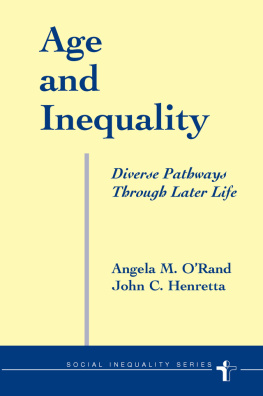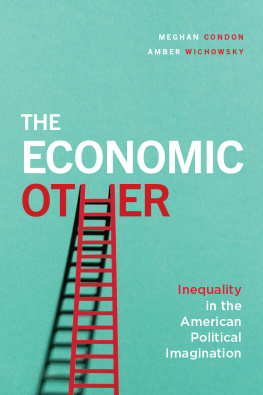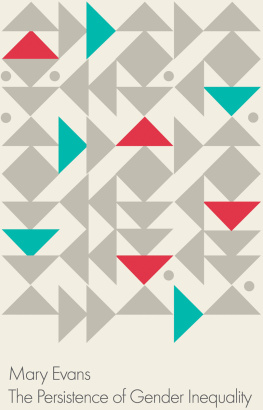Age and Inequality
Social Inequality Series
Marta Tienda and David B. Grusky, Series Editors
Age and Inequality: Diverse Pathways Through Later Life,
Angela M. O'Rand and John C. Henretta
Children , Schools, and Inequality,
Doris R. Entwisle and Karl Len Alexander
Rational Choice Theory and Large-Scale Data Analysis,
edited by Hans-Peter Blossfeld and Gerald Prein
Generating Social Stratification: Toward a New Research Agenda,
edited by Alan C. Kerckhoff
Social Stratification: Class, Race, and Gender in Sociological Perspective,
edited by David B. Grusky
Age and Inequality
Diverse Pathways Through Later Life
Angela M. O'Rand
John C. Henretta
Social Inequality Series
First published 1999 by Westview Press
Published 2018 by Routledge
711 Third Avenue, New York, NY 10017, USA
2 Park Square, Milton Park, Abingdon, Oxon OX14 4RN
Routledge is an imprint of the Taylor & Francis Group, an informa business
Copyright 1999 by Taylor & Francis
All rights reserved. No part of this book may be reprinted or reproduced or utilised in any form or by any electronic, mechanical, or other means, now known or hereafter invented, including photocopying and recording, or in any information storage or retrieval system, without permission in writing from the publishers.
Notice:
Product or corporate names may be trademarks or registered trademarks, and are used only for identification and explanation without intent to infringe.
Library of Congress Cataloging-in-Publication Data
O'Rand, Angela M.
Age and Inequality: diverse pathways through later life /
Angela M. O'Rand, John C. Henretta.
p. cm. (Social inequality series)
Includes bibliographical references and index.
ISBN 0-8133-1906-4 (hc)0-8133-9812-6 (pb)
1. AgedUnited StatesEconomic conditions. 2. EqualityUnited
States. I. Henretta, John C. II. Title. III. Series.
HQ1064.U50665 1999
305.26'0973dc21 99-30973
CIP
ISBN 13: 978-0-8133-9812-9 (pbk)
I returned, and saw under the sun, that the race is not to the swift, nor the battle to the strong, neither yet bread to the wise, nor yet riches to men of understanding, nor yet favor to men of skill; but time and chance happeneth to them all.
Ecclesiastes 9:11
If thou hast gathered nothing in thy youth, how canst thou find any thing in thine age?
Apocrypha Ecclesiasticus 25:3
This volume examines the structural and individual processes that differentiate the life course of men and women and yield patterns of inequality in adulthood and old age. Demographic, economic, and political trends have led to the increased differentiation of the life course of men and women. Processes of age structuring and gender structuring of the life course have produced mixed patterns of uniformity and diversity in life transition schedules. Meanwhile age structures and gender structures are themselves being transformed by global processes associated with population aging, economic restructuring, and welfare state reorganization. Master trends in the United States and other industrial countries have developed, and they include the following: (1) an increase in inequality within and across age-groups; (2) the shortening of men's work lives; (3) the lengthening of women's work lives; (4) diverse family arrangements and schedules; (5) earlier retirement of some segments of the workforce; (6) the synchronization of joint retirement among older couples; and (7) the feminization of poverty into late life. These patterns are observable across societies, with some systematic variations. Our primary focus is on changes in life course patterns over recent decades in the United States. However, strategic comparisons of the United States with other Western countries are also presented.
introduces these master trends. Aging and inequality are interrelated in complex ways. On the one hand, age is a relatively enduring principle of stratification in developed countries. Age serves to allocate differential government resources to the young and the old. It is also an efficient mechanism for setting timetables in the workplace. Access to employee benefits that include pensions, disability insurance, and some kinds of health insurance are frequently tied to age. Age is also highly correlated with entry into and exit from major life statuses related to schooling, work, family formation, and dissolution, empty nest, and retirement.
On the other hand, recent decades are notable for the decreasing importance of age for the conduct of more and more social roles. The age at which marriage, full-time work, childbearing, and retirement begin, and at which schooling, the work career, marriage, childbearing, and family care giving end, have become more variable. Historical circumstances have introduced succeeding cohorts to changing life conditions and new uncertainties, leading to a loosening of the association between age and social roles.
Increased variability in the life course is also associated with increased economic inequality. Diverse life pathways have different economic implications for later life. Some studies suggest that inequality is an inevitable outcome of social aging and the differentiation of cohorts over time. What is being debated is whether, and under what circumstances, individuals in the same cohort become more unequal. The United States exhibits among the highest levels of inequality across the age span, including perhaps the highest relative inequality among the elderly when compared to other nations. In addition, an apparent surge in economic inequality worldwide has attracted the recent attention of many scholars who are concerned with how inequality is produced over the life course over cycles of prosperity, stagnation, and decline.
examines pathways to inequality within aging cohorts. The interplay of employment, family, and state welfare institutions is central to the production of variability and inequality in the structure of the life course and in late-life outcomes. Earnings over the work career are the strongest predictors of economic status in retirement, both for retired workers and for their spouses and survivors. Social Security and pension income account for over four-fifths of the median income of retired households. Accordingly, labor force behavior and workplace institutions are critical components of aging and inequality. In addition, public sector institutions such as old age insurance and monetary and in-kind transfers serve to offset inequalities stemming from the workplace for workers and their families. The product of the interaction among these institutional spheres includes complex patterns of inequality and processes of status maintenance, status leveling, and cumulative advantage.
terns in ways that facilitate inequality. Traditional "breadwinner" families receive more support in employment and welfare policies, although changing social roles in the family are challenging these institutions. The implications of the interdependence among family workplace, and state are especially significant for women, who are more likely to face a longer time in old age alone with higher risks for poverty.
closely examines complex pathways through later life, including the heterogeneity of pathways to retirement. Retirement has become a common feature of life in industrial societies. Traditional pathways through work and pension acquisition have contributed to its universality. Yet alternative pathways to retirement are also institutionalized and contribute to the heterogeneity of the retirement transition. The intersection of individual biographies with alternative institutional arrangements that include unemployment, disability, and family statusas well as pensions derived from employmentallocates individuals within cohorts along different pathways from work to retirement and from dependence on earnings to dependence on different transfer programs. The scheduling of these transitions increases variability and inequality in old age.





